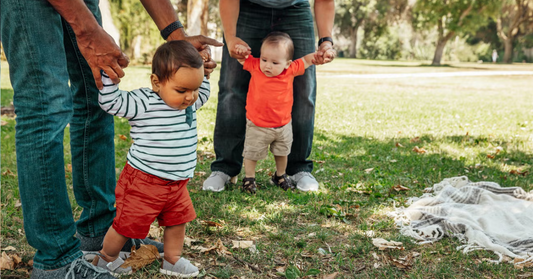Overstimulation in Babies: Causes, Signs, and Effective Calming Strategies

Babies’ rapidly developing senses can become overwhelmed by bright lights, loud noises, or too much interaction. Recognizing signs of overstimulation—such as fussiness, turning away from stimuli, and persistent crying—allows parents to respond with calming strategies that encourage healthy growth.
1. Introduction
“Overstimulation in babies happens when their developing brains struggle to process an excess of sounds, sights, and general sensations. Understanding how this occurs, as well as signs and preventative tips, helps parents nurture a calm and supportive environment.”
Raising a newborn can be one of the most exhilarating yet challenging times in a parent’s life. Amid daily feedings, naps, tummy time and playtimes, it’s easy to forget that infants have limited capacity for handling large amounts of sensory input. When exposed to too many stimuli at once—be it noise, crowds, lights, or physical interaction—babies can quickly become overwhelmed. This article explores the causes of overstimulation, how to recognize the warning signs, methods for soothing an overstimulated baby, and practical ways to prevent overstimulation in the first place.
2. What Is Overstimulation in Babies?
“Overstimulation in babies occurs when external stimuli—such as bright lights or continuous noise—become too overwhelming for their rapidly developing senses.”
Babies are hard-wired to learn and experience the world around them, yet their brains are still developing at an incredible pace. Activities that might seem ordinary or minimal to adults, like a noisy living room or a brightly lit restaurant, can feel like a flood of input to an infant. Because they crave the right balance between stimulation and rest, babies depend on parents to regulate the amount of sensory information coming their way. Overstimulation triggers a stress response—fussiness, restlessness, or crying—that signals the need for a calmer environment and soothing techniques.
3. Can Babies Be Overstimulated?
“Yes, babies can be overstimulated when they receive more sensory input than their developing nervous systems can handle, leading to crying, fussiness, or difficulty sleeping,” Dr. Kevin Kathrotia, a neonatologist and pediatrician with Millennium Medical Group (USA), explains.
It’s a common misconception that babies can’t ever have “too much” stimulation. In reality, they can indeed get overwhelmed with excessive touching, talking, loud noises, and high-energy environments, especially if these activities happen back-to-back with no downtime. While playtime is crucial for development, it is equally important to know when to slow down and let the baby reset. Babies thrive on routine and familiarity, so sporadic interruptions or intense social interactions may increase their stress levels and cause them to feel overstimulated.

4. What Causes Overstimulation in Babies?
“Busy crowds, loud music, constant exposure to screens, and frequent passing around among relatives can overload an infant’s senses, resulting in overstimulation.”
Several factors contribute to overstimulation in infants, including environmental noise, frequent handling by multiple people, and excessive sensory input from television or smartphones. Even a well-meaning family gathering can be too stimulating if everyone takes turns cuddling, talking, or playing with the baby without pauses. Additionally, modern living conditions—such as bright household lighting and constant background noise—can compound the effects. Awareness of these triggers allows parents to manage environments and routines better to keep their little ones feeling calm and secure.
5. How to Tell If a Baby Is Overstimulated (Signs of Overstimulation)
“Fussiness, averting eye contact, clenched fists, turning the head away, and persistent crying are all common signs your baby might be overstimulated,” Armando Castillo Jr, M.D., a neonatologist at Millennium Medical Group (USA), explains.
Parents may initially mistake these clues for hunger or tiredness. However, when the usual soothing attempts—like feeding or changing—don’t help, it may be time to consider overstimulation. Some babies show subtle signs such as rubbing their eyes, difficulty focusing, or refusing to engage in typical play. They might stiffen their bodies or repeatedly arch their backs. Paying close attention to these baby cues not only helps you identify overstimulation faster but also allows you to develop a response strategy that minimizes the buildup of excess stimuli.
This video was published by the Minnesota Department of Health.
6. How to Calm an Overstimulated Baby
“Gently removing your baby from the source of stimulation and settling them in a dimly lit, quiet area can work wonders for immediate soothing.”
When a baby becomes overstimulated, the first step is to reduce the volume of sensory input. Turn off televisions or loud music, close curtains to dim the lights, and limit passing around the baby among different people. A familiar routine—like swaddling, soft rocking, or singing a lullaby—can signal safety and comfort. Some infants respond well to skin-to-skin contact as parents hold them close, providing warmth and rhythmic breathing. Practicing consistent self-soothing techniques, like offering a pacifier or placing them gently in a calm, quiet corner, can also help babies regain composure.
7. Can You Overstimulate a Baby?
“Even engaging, enriching play sessions can cross the line into overstimulation if the baby doesn’t have enough time to wind down and process new experiences.”
Ensuring babies have enough restorative downtime is an essential part of healthy growth. Babies need active interaction, but if play is overly prolonged without breaks—especially involving bright lights, loud toys, or vigorous movement—they can become stressed or fussy. It may help to think in terms of intensity rather than volume: a short but lively game with exciting sounds, lights, or movement is best followed by a tranquil period of calm. Allowing your little one to pause and regroup ensures learning opportunities remain positive, rather than becoming overwhelming.
8. How to Avoid Overstimulation in Babies
“Building predictable nap schedules, taking breaks between play sessions, and managing visitors can help prevent overwhelming a baby’s senses.”
A structured daily routine is one of the most effective ways to protect your baby from overstimulation. Keeping feeding, naptimes, and bedtimes consistent allows babies to anticipate each segment of their day, making them feel secure. During family gatherings or crowded public outings, you can step away to quieter spaces when signs of overstimulation emerge. Make sure your living area includes a calm space—perhaps with softer lighting and gentle background sounds—where the baby can unwind. Reducing screen time and ensuring baby toys are age-appropriate and not overly flashy are also beneficial strategies.
9. Conclusion
“By recognizing the signs of overstimulation and responding promptly with effective calming strategies, parents can create a peaceful environment that supports their baby’s healthy development.”
Overstimulation is a genuine concern that can disrupt a baby’s otherwise content mood and hinder their well-being. As parents become aware of potential triggers, they can adapt routines, control environmental factors, and limit chaotic stimuli. Intervening quickly—by removing unnecessary sensory input and providing soothing comfort—helps babies recover faster, reducing distress for both infant and caregiver. Ultimately, prevention is often the best approach. Through balanced activities, structured quiet times, and a careful eye on each situation, parents can keep stimulation at appropriate levels, ensuring a contented and thriving baby.







0 comments